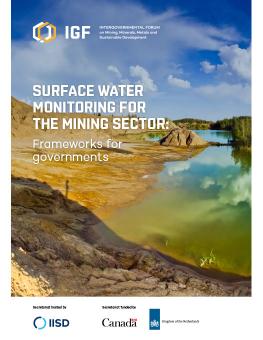
Surface Water Monitoring for the Mining Sector: Frameworks for governments
This document reviews water monitoring frameworks for mine water management by governments.
Mining activity has the potential to affect many aspects of the environment, and the responsible management of natural resources is key to preserving them for future generations. Water, in particular, is a critical resource for which competing demands may often be the root source of conflict and tension within and between communities, societies, and nations.
Governments play the critical role of balancing competing demands for water between mining, agriculture, industry, recreation, and household usage, among others. Within the context of the mining sector, governments are responsible for overseeing water extraction, use, discharge, and quality at the site, watershed, and regional levels.
To uphold this responsibility, governments must effectively monitor and evaluate mine water management efforts. Many mining nations have implemented water monitoring frameworks (WMFs), and this document reviews these existing programs to provide details on commonalities between them.
This document reviews key issues of mine water impacts on the aquatic environment along with international standards for WMFs. Then it reviews the role of governments aiming to develop and implement a WMF and summarizes available tools for policy-makers. It also reviews the implementation of participatory monitoring programs under the umbrella of a WMF.
Participating experts
You might also be interested in
2023 IGF Annual Report
Detailing an eventful year that saw the IGF Secretariat deliver several new publications, workshops, and events for its growing membership.
What Makes Minerals and Metals "Critical"?
Exploring how governments define what should be considered as "strategic" or "critical" based on a series of objective criteria.
Modernizing Artisanal and Small-Scale Mining
How will emerging technologies affect the artisanal and small-scale mining sector?
ASGM Tailings Management and Reprocessing Governance
This report outlines technical aspects, governance frameworks, and policy recommendations for artisanal and small-scale gold mining (ASGM) tailings management and reprocessing.